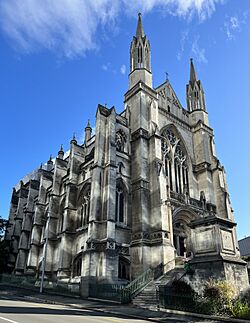St Paul's Cathedral, Dunedin facts for kids
Quick facts for kids St Paul's Cathedral |
|
|---|---|
| The Cathedral Church of St Paul the Apostle | |

St Paul's Cathedral, Dunedin
|
|
| 45°52′25″S 170°30′09″E / 45.87361°S 170.502539°E | |
| Country | New Zealand |
| Denomination | Anglican |
| Churchmanship | Liberal Anglo-Catholic |
| History | |
| Status | Cathedral |
| Founded | 8 June 1915 |
| Founder(s) | Samuel Nevill |
| Dedication | Paul the Apostle |
| Consecrated |
|
| Architecture | |
| Functional status | Active |
| Architect(s) |
|
| Architectural type | Church |
| Years built | 1915 – 2003 |
| Specifications | |
| Materials | Concrete, Oamaru limestone, Italian marble, Australian jarrah |
| Administration | |
| Diocese | Dunedin |
St Paul's Cathedral is a beautiful Anglican cathedral in the center of Dunedin, New Zealand. A cathedral is the main church for a large area, called a diocese. St Paul's is located in a public square called The Octagon, right next to the Dunedin Town Hall.
The cathedral is the main church for the Anglican Diocese of Dunedin. Because of its importance, it is listed as a Category 1 Historic Place by Heritage New Zealand. This means it is a special building that is protected for its history.
Contents
The Story of St Paul's Cathedral
The land where the cathedral stands was a gift from a man named Johnny Jones, who was an early settler in the area.
The First Church on the Site
The very first church of St Paul was built on this spot between 1862 and 1863. It was made from a local stone called Caversham stone and could hold about 500 people.
However, the church wasn't built very well. The stone started to crumble over time. It had a tall spire, but it had to be taken down after only a few years because it wasn't safe.
Becoming a Cathedral
In 1871, Samuel Nevill became the Bishop of Dunedin. He thought the city needed a proper cathedral. For many years, people could not agree on whether to make St Paul's the cathedral or choose another church.
Finally, in 1894, after 18 years of discussion, everyone agreed that St Paul's would become the cathedral for the diocese. A special group called the cathedral chapter was formed in 1895 to look after it.
Building a Grand New Cathedral
In 1904, a local businessman named William Harrop left a large amount of money in his will to build a new cathedral. But there was a condition: the church had to raise £20,000 on its own first.
Bishop Nevill worked hard to raise the money. By 1913, they had reached their goal, and work on the new building could start. The design for the cathedral came from an architect in England named Edmund Harold Sedding.
The first stone of the new cathedral was laid on June 8, 1915. The builders created huge foundations and a massive stone vaulted ceiling. This arched ceiling is the only one of its kind in New Zealand made entirely of stone.
But they ran out of money and couldn't finish the whole building. They built a temporary wall at the end of the main hall, or nave. The new, partly-finished cathedral was officially opened on February 12, 1919.
A Modern Addition
In the 1960s, church leaders decided to finally finish the cathedral, but with a new, modern design. An architect named Ted McCoy drew up the plans for a new section at the front of the church, called the chancel.
Work began in 1969. The new chancel was very different from the older part of the cathedral. It had tall, clear glass windows and modern furniture. The new section was finished in 1971.
Fire and Restoration
In August 2020, a fire broke out in the roof of the modern chancel. It caused a lot of damage to that part of the building.
Work to repair the roof and restore the damaged areas began soon after. The restoration was completed in 2023. This was part of a larger plan to make the cathedral more welcoming for visitors.
A Welcoming Church
St Paul's describes itself as an "Inclusive Church." This means it aims to be a welcoming place for everyone, no matter their background, culture, or abilities.
In 1989, St Paul's became famous when Penny Jamieson was made the Bishop of Dunedin there. She was the first woman in the world to become the head of a diocese in the Anglican Church.
Music at the Cathedral
Music is a very important part of life at St Paul's. The cathedral is known for its excellent choir and its powerful organ.
The Cathedral Choir
The St Paul's Cathedral choir has a long history of high-quality singing. Many of its members have gone on to become professional singers around the world. The choir sings at Sunday services and special events. It has a challenging song list, from very old music to modern songs.
The Organ
The cathedral's organ is huge, with more than 3,500 pipes. It was built in London in 1919 and installed in Dunedin the next year. In 1972, it was taken apart and moved to a new position inside the cathedral. Because it is such a great instrument, it is often used for concerts and special city events.
Gallery








